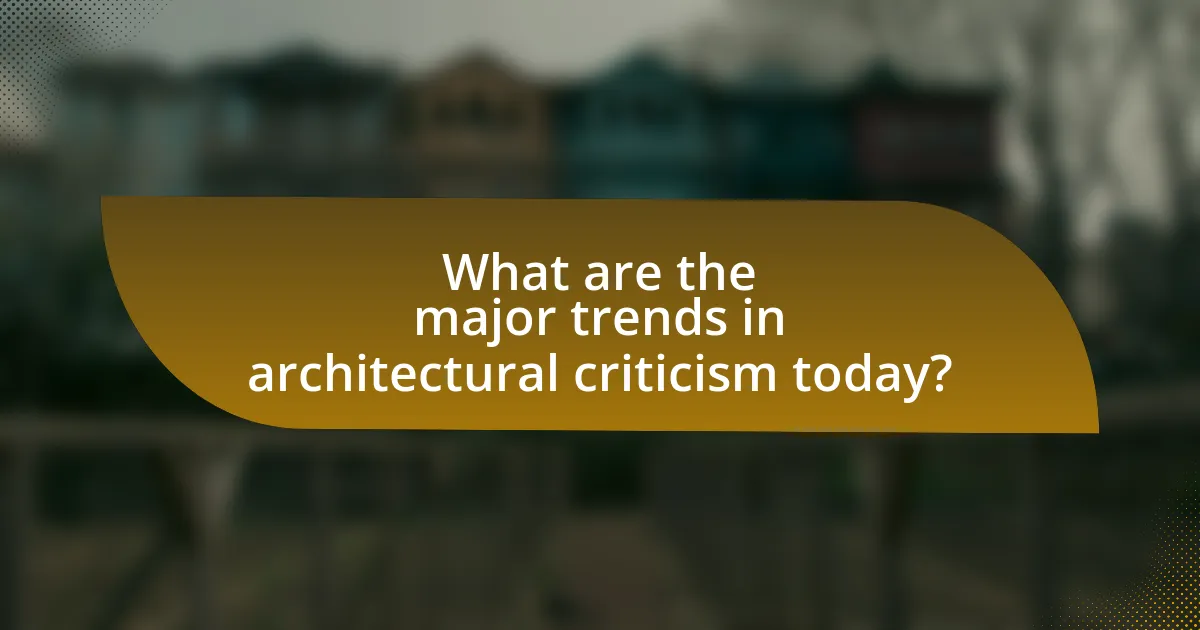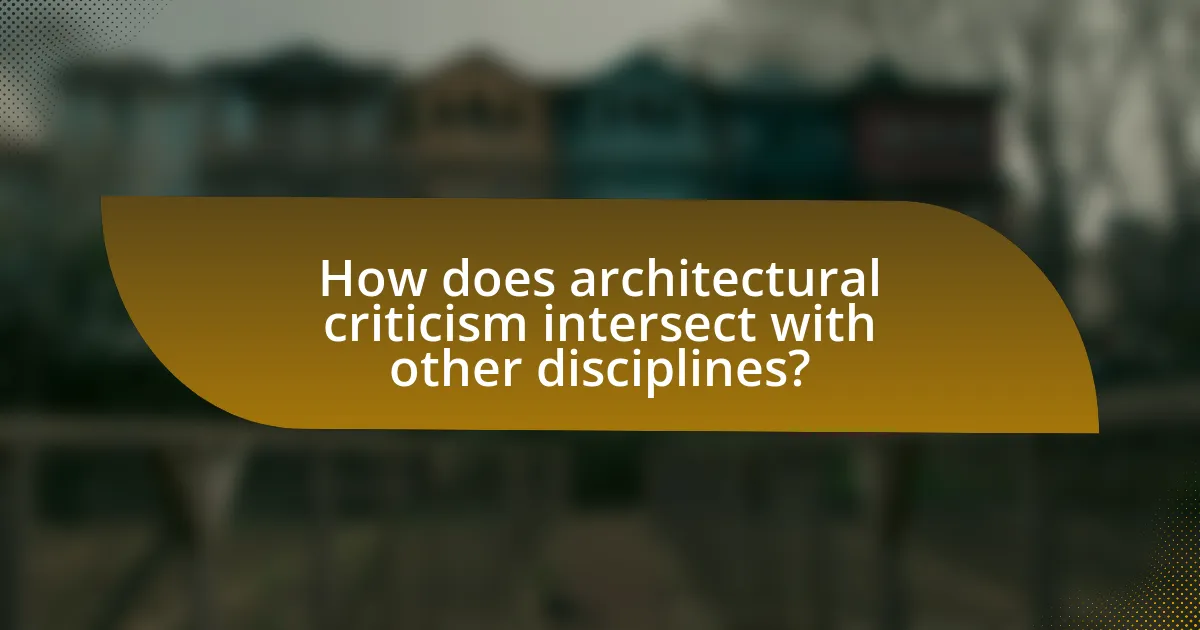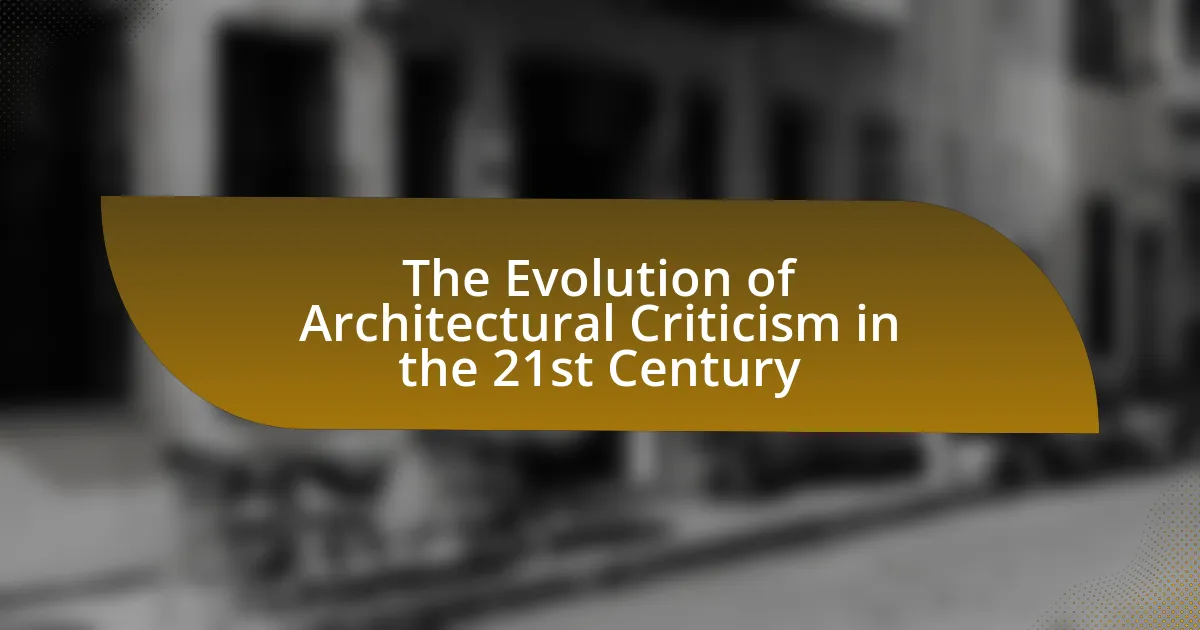The article examines the evolution of architectural criticism in the 21st century, highlighting the transition from traditional print media to digital platforms that promote inclusivity and diverse voices. It discusses how this shift has democratized architectural discourse, allowing for immediate feedback and broader participation while emphasizing social, environmental, and political contexts in critiques. Key factors driving this evolution include technological advancements, a focus on sustainability, and the integration of interdisciplinary approaches, which collectively shape contemporary architectural criticism and its role in informing public perception and urban planning.

What is the Evolution of Architectural Criticism in the 21st Century?
The evolution of architectural criticism in the 21st century has been marked by a shift towards digital platforms and a more diverse range of voices. Traditional print media has declined, leading to the rise of online publications, blogs, and social media, which allow for immediate feedback and broader accessibility. This transition has democratized architectural discourse, enabling critics from various backgrounds to contribute, thus enriching the conversation around architecture. Additionally, the focus has expanded beyond aesthetics to include social, environmental, and political implications of architecture, reflecting contemporary concerns such as sustainability and urbanism. This evolution is evidenced by the emergence of influential online platforms like ArchDaily and Dezeen, which prioritize inclusivity and diverse perspectives in architectural criticism.
How has architectural criticism changed in the 21st century?
Architectural criticism in the 21st century has shifted towards a more inclusive and interdisciplinary approach, emphasizing diverse voices and perspectives. This change is evident in the rise of digital platforms, which allow for broader participation and immediate feedback, contrasting with the traditional print media that dominated the previous century. Additionally, contemporary criticism often incorporates social, environmental, and political contexts, reflecting a growing awareness of architecture’s impact on society. For instance, the emergence of critiques that address sustainability and urban equity highlights the evolving priorities within the field.
What are the key factors driving this evolution?
The key factors driving the evolution of architectural criticism in the 21st century include the rise of digital media, increased accessibility to architectural discourse, and the growing emphasis on sustainability and social responsibility. Digital media platforms have transformed how architectural criticism is disseminated, allowing for immediate feedback and broader audience engagement. This shift has democratized the conversation around architecture, enabling diverse voices to contribute to the discourse. Additionally, the focus on sustainability reflects a societal shift towards environmentally conscious design, influencing critics to evaluate architecture not only on aesthetic merit but also on its ecological impact. These factors collectively shape the contemporary landscape of architectural criticism, making it more inclusive and relevant to current global challenges.
How do technological advancements influence architectural criticism?
Technological advancements significantly influence architectural criticism by providing new tools and platforms for analysis and dissemination. For instance, the rise of digital modeling software and virtual reality allows critics to evaluate designs in immersive environments, enhancing their understanding of spatial relationships and materiality. Additionally, social media platforms enable immediate feedback and broader engagement with architectural works, democratizing the critique process. A study by the Architectural League of New York highlights that critics now utilize data analytics to assess public reception and environmental impact, further informing their evaluations. These advancements reshape the criteria and methods of architectural criticism, making it more dynamic and responsive to contemporary contexts.
Why is architectural criticism important in contemporary society?
Architectural criticism is important in contemporary society because it fosters informed public discourse about the built environment. This form of critique helps to evaluate and interpret architectural works, influencing design practices and urban planning. By analyzing aesthetics, functionality, and social impact, architectural criticism contributes to a deeper understanding of how buildings affect communities and individual lives. For instance, the rise of sustainable architecture has been significantly shaped by critical discussions that highlight environmental concerns and social equity, leading to more responsible design choices.
What role does it play in shaping public perception of architecture?
Architectural criticism plays a crucial role in shaping public perception of architecture by providing informed evaluations and interpretations of built environments. This critical discourse influences how the public understands architectural significance, aesthetics, and functionality. For instance, prominent critics like Ada Louise Huxtable have historically shaped public opinion through their reviews, which often highlight the cultural and social implications of architectural works. Furthermore, architectural criticism in the 21st century has evolved with digital platforms, allowing for broader dissemination of opinions and fostering public engagement with architecture, thereby directly impacting societal values and expectations regarding design.
How does it contribute to the discourse on sustainability and design?
The evolution of architectural criticism in the 21st century significantly contributes to the discourse on sustainability and design by emphasizing the integration of ecological principles into architectural practices. This shift is evidenced by the increasing focus on sustainable materials, energy-efficient designs, and the impact of architecture on climate change. For instance, the rise of green building certifications, such as LEED, reflects a growing recognition of the need for environmentally responsible design, which is often discussed in contemporary architectural critiques. These critiques not only evaluate aesthetic and functional aspects but also assess the environmental implications of architectural choices, thereby fostering a more holistic understanding of design’s role in sustainability.

What are the major trends in architectural criticism today?
Major trends in architectural criticism today include a focus on sustainability, social equity, and the impact of technology on design. Critics increasingly emphasize the importance of environmentally responsible practices, reflecting a growing awareness of climate change and resource depletion. For instance, the rise of green architecture has prompted critics to evaluate buildings based on their ecological footprint and energy efficiency. Additionally, there is a heightened focus on social equity, with critics advocating for designs that address issues of accessibility and community engagement. This trend is evident in discussions surrounding affordable housing and urban revitalization projects. Furthermore, the integration of technology in architecture, such as the use of digital tools for design and construction, has transformed the way critics assess architectural works, leading to new dialogues about innovation and functionality. These trends collectively shape contemporary architectural criticism, reflecting broader societal concerns and advancements.
How has the rise of digital media impacted architectural criticism?
The rise of digital media has significantly transformed architectural criticism by democratizing access to information and enabling diverse voices to participate in the discourse. Digital platforms allow critics to share their insights instantly, reaching a global audience and fostering real-time discussions. For instance, social media channels and blogs have emerged as vital spaces for critique, where both professionals and enthusiasts can engage with architectural works, leading to a broader range of perspectives. This shift has also resulted in a more visual and multimedia-oriented approach to criticism, as critics utilize images, videos, and interactive content to enhance their analyses. The accessibility of digital media has thus reshaped the landscape of architectural criticism, making it more inclusive and dynamic.
What platforms are most influential in contemporary architectural discourse?
The most influential platforms in contemporary architectural discourse include digital publications, social media, and architectural forums. Digital publications such as ArchDaily and Dezeen provide extensive coverage of architectural projects and trends, reaching a global audience and shaping public perception. Social media platforms like Instagram and Pinterest allow architects and designers to showcase their work visually, influencing trends and discussions in real-time. Architectural forums, including platforms like the Architectural Review and Designboom, facilitate critical discussions among professionals, fostering a community that engages with contemporary issues in architecture. These platforms collectively shape the narrative and evolution of architectural criticism in the 21st century.
How do social media and blogs shape public engagement with architecture?
Social media and blogs significantly shape public engagement with architecture by democratizing access to architectural discourse and enabling real-time interaction. These platforms allow a diverse audience to share opinions, critique designs, and showcase architectural projects, thus fostering a more inclusive dialogue. For instance, platforms like Instagram and Pinterest enable users to visually engage with architecture, while blogs provide in-depth analysis and commentary, reaching audiences that traditional media may overlook. According to a study published in the Journal of Architectural Education, social media has transformed architectural criticism by allowing non-professionals to participate in discussions, thereby broadening the scope of public engagement and influencing architectural trends.
What are the emerging voices in architectural criticism?
Emerging voices in architectural criticism include individuals like Amanda Levete, who emphasizes the intersection of architecture and technology, and Justin Davidson, known for his insightful commentary on urbanism and public space. These critics are reshaping the discourse by integrating contemporary issues such as sustainability, social equity, and digital innovation into their analyses. Their contributions reflect a shift towards a more inclusive and interdisciplinary approach in architectural criticism, addressing the complexities of modern society and the built environment.
Who are the leading critics and what perspectives do they offer?
Leading critics in architectural criticism include Michael Kimmelman, who emphasizes the social impact of architecture, and Paul Goldberger, who focuses on the aesthetic and cultural significance of buildings. Kimmelman, as the architecture critic for The New York Times, advocates for designs that enhance community engagement and public spaces, arguing that architecture should serve societal needs. Goldberger, a Pulitzer Prize-winning critic, highlights the importance of context and historical relevance in architecture, asserting that buildings should resonate with their surroundings and reflect cultural narratives. Their perspectives illustrate a shift towards a more holistic understanding of architecture, integrating social, aesthetic, and cultural dimensions.
How do diverse backgrounds influence critical viewpoints in architecture?
Diverse backgrounds significantly influence critical viewpoints in architecture by introducing varied cultural, social, and historical perspectives that shape design interpretations. Architects and critics from different ethnicities, genders, and socioeconomic statuses bring unique experiences that inform their understanding of space, aesthetics, and functionality. For instance, research by the American Institute of Architects highlights that diverse teams produce more innovative solutions, as they challenge conventional norms and address a broader range of community needs. This diversity fosters a richer dialogue in architectural criticism, leading to more inclusive and representative built environments.

How does architectural criticism intersect with other disciplines?
Architectural criticism intersects with other disciplines such as art, sociology, urban planning, and environmental studies by analyzing the built environment through various lenses. For instance, art criticism informs architectural criticism by evaluating aesthetics and design principles, while sociology examines the social implications of architectural spaces on communities. Urban planning contributes by addressing the functionality and integration of buildings within cityscapes, and environmental studies highlight sustainability and ecological impacts of architectural practices. This interdisciplinary approach enriches architectural criticism, allowing for a more comprehensive understanding of how architecture influences and is influenced by societal, cultural, and environmental factors.
What connections exist between architectural criticism and urban studies?
Architectural criticism and urban studies are interconnected through their shared focus on the built environment and its impact on society. Architectural criticism evaluates the design, aesthetics, and functionality of buildings, while urban studies examines the broader context of urban spaces, including social, economic, and political factors. This relationship is evident in how architectural critics often analyze buildings within the framework of urban development, considering how architectural choices influence community dynamics and urban identity. For instance, the work of architectural critics like Robert Venturi has highlighted the importance of context in urban design, emphasizing that architecture cannot be divorced from its urban setting. This synergy between the two fields fosters a comprehensive understanding of how architecture shapes and is shaped by urban life.
How does architectural criticism inform urban planning and policy?
Architectural criticism informs urban planning and policy by providing evaluative insights that shape design decisions and community needs. Critics analyze built environments, highlighting strengths and weaknesses, which influences planners and policymakers to prioritize sustainable, functional, and aesthetically pleasing developments. For instance, critiques of urban sprawl have led to policies promoting smart growth and mixed-use developments, as seen in cities like Portland, Oregon, where urban design is guided by critical assessments of livability and environmental impact. This feedback loop ensures that urban planning is responsive to public sentiment and expert analysis, ultimately leading to more effective and inclusive urban policies.
What insights can be gained from interdisciplinary approaches to criticism?
Interdisciplinary approaches to criticism yield insights that enhance the understanding of architectural discourse by integrating diverse perspectives, methodologies, and theoretical frameworks. By combining insights from fields such as sociology, psychology, and environmental science, critics can analyze the social implications of architectural designs, the psychological impact of space on human behavior, and the environmental sustainability of structures. For instance, research by the American Institute of Architects highlights how incorporating social science can lead to more community-focused designs, ultimately improving user experience and engagement. This multifaceted analysis fosters a richer critique that addresses not only aesthetic values but also functional, cultural, and ethical dimensions of architecture.
How does architectural criticism address social issues?
Architectural criticism addresses social issues by analyzing how built environments impact communities and reflect societal values. Critics evaluate designs not only for aesthetic merit but also for their implications on social equity, accessibility, and environmental sustainability. For instance, critiques of urban development often highlight the displacement of marginalized populations, emphasizing the need for inclusive planning practices. This approach is supported by studies such as “The Role of Architecture in Social Justice” by authors like David Harvey, which argue that architecture can either perpetuate or challenge social inequalities. Through this lens, architectural criticism serves as a platform for advocating social change and promoting designs that foster community well-being.
What role does it play in advocating for equity and inclusion in design?
Architectural criticism plays a crucial role in advocating for equity and inclusion in design by highlighting diverse perspectives and challenging traditional norms. This form of critique encourages designers to consider the needs of marginalized communities, ensuring that their voices are represented in the built environment. For instance, architectural critics often analyze projects through the lens of social justice, emphasizing the importance of accessibility and cultural relevance. By doing so, they promote designs that are not only functional but also equitable, fostering environments that serve all members of society.
How can criticism influence community engagement in architectural projects?
Criticism can significantly enhance community engagement in architectural projects by fostering dialogue and encouraging public participation. When architectural criticism is constructive, it invites community members to express their opinions, leading to a more inclusive design process. For instance, studies have shown that projects with active community feedback mechanisms, such as public forums or surveys, result in designs that better reflect the needs and desires of the community, ultimately increasing satisfaction and ownership of the space. Furthermore, criticism can highlight potential issues or concerns early in the design phase, allowing architects to address them proactively, which strengthens trust and collaboration between architects and the community.
What are best practices for engaging with architectural criticism?
Best practices for engaging with architectural criticism include actively listening to diverse perspectives, fostering open dialogue, and grounding discussions in factual analysis. Engaging with criticism requires architects and critics to approach conversations with a willingness to understand differing viewpoints, which can enhance the quality of discourse. For instance, the Royal Institute of British Architects emphasizes the importance of constructive feedback in shaping architectural practices. Additionally, utilizing evidence-based arguments, such as historical precedents or case studies, strengthens the validity of critiques and promotes informed discussions.
How can architects and designers benefit from critical feedback?
Architects and designers can benefit from critical feedback by gaining insights that enhance their design processes and outcomes. This feedback allows them to identify strengths and weaknesses in their work, leading to improved functionality, aesthetics, and user experience. For instance, studies show that constructive criticism can lead to innovative solutions and more effective designs, as it encourages professionals to rethink their approaches and consider diverse perspectives. By engaging with critical feedback, architects and designers can refine their skills, adapt to changing trends, and ultimately produce more successful projects.
What strategies can critics use to foster constructive dialogue?
Critics can foster constructive dialogue by employing strategies such as active listening, framing critiques positively, and encouraging diverse perspectives. Active listening allows critics to fully understand the viewpoints of others, which can lead to more meaningful exchanges. By framing critiques positively, critics can highlight strengths while addressing weaknesses, making discussions more collaborative rather than confrontational. Encouraging diverse perspectives invites a broader range of opinions, enriching the dialogue and promoting inclusivity. These strategies are supported by research indicating that constructive communication enhances understanding and collaboration in discussions, particularly in fields like architecture where multiple viewpoints are essential for innovation.
